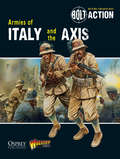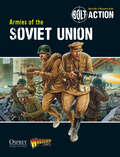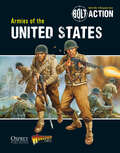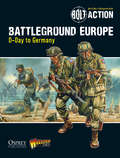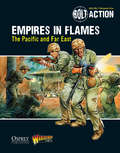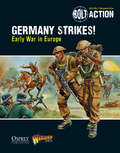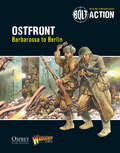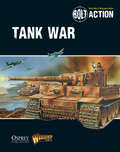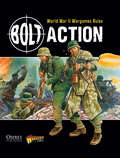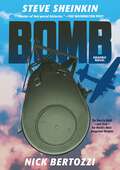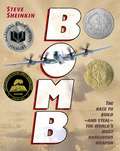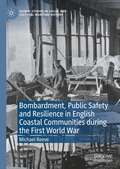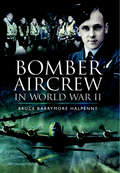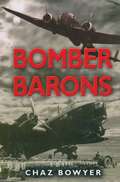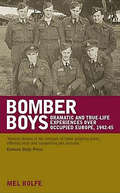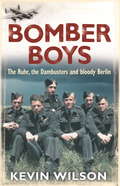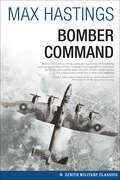- Table View
- List View
Bolt Action: Armies of Italy and the Axis
by Warlord GamesWhile many nations flocked to the side of the Allies, others joined forces with Germany as part of the Axis. This volume is the definitive guide to the armies of Italy, Hungary, Slovakia, Croatia and Finland. Refight the Winter War against the Soviets, hold back the British in North Africa, or help shore up the German offensives on the Eastern Front with this latest supplement for Bolt Action.
Bolt Action: Armies of the Soviet Union
by Warlord GamesStalin's Russian Winter War against Finland, and his World War II campaigns on Nazi Germany's eastern front (around Kiev, Lenningrad, Moscow, Kharkov, Stalingrad, Kursk, Byelorussia, the Balkans, East Prussia, Warsaw, Hungary, and Berlin) constitute the largest land war in world history in terms of the number of troops engaged, and is also impressive in terms of the vast distances fought over. Russia took 20 million military and 20 million civilian casualties during a brutal four year war, and the Germans lost over 2 million military and 2 million civilian casualties as well. Bolt Action allows gamers to recreate a small part of this titanic struggle on the table-top.
Bolt Action: Armies of the United States
by Peter Dennis Warlord GamesWith this latest supplement for Bolt Action, players now have all the information they need to field the varied military forces of the United States of America. Entering the war after the attack on Pearl Harbor, the United States immediately went to war on several fronts. In Europe and Africa, the Americans battled against the Germans and Italians, while in the Pacific the soldiers of the Army and Marines faced the forces of Imperial Japan. This book allows players to choose from dozens of different troop types including Sherman tanks, Marine raiders, and paratroopers, and build a US force to fight in any theatre of the war.
Bolt Action: Battleground Europe
by Peter Dennis Warlord GamesTake the fight to the enemy with this new theatre book for Bolt Action. From the D-Day landings to the final battle for Berlin, this volume gives players everything they need to focus their gaming on these final campaigns in the ETO. Scenarios and special rules offer something for all Bolt Action players, regardless of the armies they collect.
Bolt Action: Empires in Flames
by Peter Dennis Warlord GamesFar from the battlefields of Europe and North Africa, Allied forces fought a very different war against another foe. From the jungles of Burma to the islands of the Pacific and the shores of Australia, this new theater supplement for Bolt Action allows players to command the spearhead of the lightning Japanese conquests in the East or to fight tooth and nail as Chindits, US Marines and other Allied troops to halt the advance and drive them back. Scenarios, special rules and new units give players everything they need to recreate the ferocious battles and campaigns of the Far East, from Guadalcanal to Okinawa, from Singapore to the Phillipines, Iwo Jima and beyond.
Bolt Action: Germany Strikes!
by Peter Dennis Warlord GamesIn 1939, Germany shattered the peace of Europe with a lightning-quick strike against Poland. The next year, it captured Denmark and Norway, before launching its famous blitzkrieg against France, Belgium and The Netherlands. In less than two years of fighting, Nazi Germany had become the master of mainland Europe. This new theater book for Bolt Action allows players to command armies of Germany tanks in WWII driving across the lowlands or to lead the desperate defense of the outgunned allied armies.
Bolt Action: Ostfront
by Peter Dennis Warlord GamesTake charge of Operation Barbarossa and drive towards Moscow or command the steadfast defenders of the Soviet Union. From the early battles for Leningrad and Sevastopol to the tank clash of Kursk and the bitter urban warfare of Stalingrad, this new theatre supplement for Bolt Action provides players with new scenarios and special rules that give them everything they need to focus their gaming on the Eastern Front.
Bolt Action: Tank War
by Peter Dennis Warlord GamesTank War, the new supplement for Bolt Action, gives players the option to expand their games to a whole new level - armored warfare. Recreate such great engagements as the battle of Kursk with the scenarios, army options and special rules found in this book. Whether you want to add more armour to your existing armies or build an entirely armoured force, Tank War has you covered.
Bolt Action: World War II Wargames Rules
by Warlord GamesUsing miniature soldiers, tanks and terrain, you can fight battles in the shattered towns of occupied France, the barren deserts of North Africa, and even the sweltering jungles of the Pacific. Written by veteran game designers Alessio Cavatore and Rick Priestley, Bolt Action provides all the rules needed to bring the great battles of World War II to your tabletop. Players get to decide which of the major or minor World War II powers they would like to represent, and then construct their armies from the lists provided. Army options are almost limitless, allowing you to build the kind of army that most appeals to your style of play, from heavily armored tank forces to lightly armed, but highly skilled. The choice is yours. Created as a joint project between Warlord Games, the premiere historical miniatures company, and Osprey Publishing, the leading independent military history publisher, Bolt Action is sure to be the most popular new wargame on the market.
Bomb (Graphic Novel): The Race to Build--and Steal--the World's Most Dangerous Weapon
by Steve SheinkinA riveting graphic novel adaptation of the award-winning nonfiction book, Bomb—the fascinating and frightening true story of the creation behind the most destructive force that birthed the arms race and the Cold War.In December of 1938, a chemist in a German laboratory made a shocking discovery: When placed next to radioactive material, a Uranium atom split in two. That simple discovery launched a scientific race that spanned three continents. In Great Britain and the United States, Soviet spies worked their way into the scientific community; in Norway, a commando force slipped behind enemy lines to attack German heavy-water manufacturing; and deep in the desert, one brilliant group of scientists was hidden away at a remote site at Los Alamos. This is the story of the plotting, the risk-taking, the deceit, and genius that created the world's most formidable weapon. This is the story of the atomic bomb. New York Times bestselling author Steve Sheinkin's award-winning nonfiction book is now available reimagined in the graphic novel format. Full color illustrations from Nick Bertozzi are detailed and enriched with the nonfiction expertise Nick brings to the story as a beloved artist, comic book writer, and commercial illustrator who has written a couple of his own historical graphic novels, including Shackleton and Lewis & Clark. Accessible, gripping, and educational, this new edition of Bomb is perfect for young readers and adults alike.Praise for Bomb (2012):“This superb and exciting work of nonfiction would be a fine tonic for any jaded adolescent who thinks history is 'boring.' It's also an excellent primer for adult readers who may have forgotten, or never learned, the remarkable story of how nuclear weaponry was first imagined, invented and deployed—and of how an international arms race began well before there was such a thing as an atomic bomb.” —The Wall Street Journal “This is edge-of-the seat material that will resonate with YAs who clamor for true spy stories, and it will undoubtedly engross a cross-market audience of adults who dozed through the World War II unit in high school.” —The Bulletin (starred review)Also by Steve Sheinkin: Fallout: Spies, Superbombs, and the Ultimate Cold War Showdown The Port Chicago 50: Disaster, Mutiny, and the Fight for Civil Rights Undefeated: Jim Thorpe and the Carlisle Indian School Football Team Most Dangerous: Daniel Ellsberg and the Secret History of the Vietnam WarBorn to Fly: The First Women's Air Race Across AmericaThe Notorious Benedict Arnold: A True Story of Adventure, Heroism & Treachery Which Way to the Wild West?: Everything Your Schoolbooks Didn't Tell You About Westward Expansion King George: What Was His Problem?: Everything Your Schoolbooks Didn't Tell You About the American Revolution Two Miserable Presidents: Everything Your Schoolbooks Didn't Tell You About the Civil War
Bomb Aimer Over Berlin: The Wartime Memoirs of Les Bartlett DFM
by Peter Jacobs Les BartlettLes Bartlett has become one of the great characters of World War II history. He flew as bomb aimer with the then Flying Officer Michael Beetham, who later became Marshal of the Royal Air Force. At that time he was a sergeant but gained his commission in April 1944 and flew his tour, including 27 raids over Germany and France between November 1943 and May 1944. On his second operation his aircraft was attacked by a Ju 88, leaving it with no flaps or brakes—a crash landing at Wittering ensued. At the end of his third mission they found the whole of Lincolnshire fogbound and eventually landed at RAF Melbourne in Yorkshire just before that airfield was closed also because of the fog. His aircraft was hit in the wing by a 30lb incendiary bomb dropped by another Lancaster flying above them on his sixth operation—but they survived. On his twelfth operation to Leipzig he used the nose guns to destroy a Ju 88 night fighter, for which he was awarded the DFM. In February 1944 the port outer engine caught fire and the crew baled out. Les was then posted as Assistant Adjutant to RAF Thornaby.
Bomb Alley: Falkland Islands 1982: Aboard HMS Antrim at War
by David YatesThis is the untold story of the Falklands War as experienced by a below-decks seaman on one of the most important ships to be despatched to the South Atlantic. It is a no-holds-barred account as seen through the eyes of a Royal Navy matelot who shared the terror of the first encounter with Argentinean forces when South Georgia was retaken from the invaders in Operation Paraquat. Then HMS Antrim lead the first attack into the North Falklands Sound where she destroyed enemy defences and later became part of the main force anti-aircraft defences in the infamous 'Bomb Alley' or San Carlos Water. During one of the many air attacks the ship was struck by a bomb that destroyed her defensive missile system, but through pure chance the bomb did not explode and remained aboard wedged in the aft 'heads'. All around the stricken ship other RN vessels were taking extreme punishment from the almost continuous onslaught from low-flying Argentinean jets. HMS Antelope, HMS Coventry and the Atlantic Conveyer were all lost within a short period whilst the army was trying to establish a bridgehead.
Bomb Disposal in World War Two
by Chris RanstedFor this book, Chris Ransted has researched some of the lesser known events and personalities relating to the early years of Explosive Ordnance Disposal in the UK. Daring acts of cold blooded bravery, and ingenuity in the face of life threatening technical challenges, are recounted throughout the book.Included are numerous previously unpublished accounts and photographs that describe the disarming of German bombs, parachute mines, and even allied bombs found at aircraft crash sites. In addition, the book contains the most comprehensive account ever published of the Home Guards role with the Auxiliary Bomb Disposal Units, and details of conscientious objectors involvement with unexploded bombs.This is not only a valuable research tool for serious researchers already well read on the subject, but also a fascinating read for those with no previous knowledge of wartime bomb disposal at all, and of course a must read for anyone interested in the subject.
Bomb Girls: Trading Aprons for Ammo
by Barbara Dickson2016 Speaker's Book Award — Shortlisted 2016 Heritage Toronto Book Award — Nominated An account of the women working in high-security, dangerous conditions making bombs in Toronto during the Second World War. What was it like to work in a Canadian Second World War munitions factory? What were working conditions like? Did anyone die? Just how closely did female employees embody the image of “Rosie the Riveter” so popularly advertised to promote factory work in war propaganda posters? How closely does the recent TV show, Bomb Girls, resemble the actual historical record of the day-to-day lives of bomb-making employees? Bomb Girls delivers a dramatic, personal, and detailed review of Canada’s largest fuse-filling munitions factory, situated in Scarborough, Ontario. First-hand accounts, technical records, photographic evidence, business documentation, and site maps all come together to offer a rare, complete account into the lives of over twenty-one thousand brave men and women who risked their lives daily while handling high explosives in a dedicated effort to help win the war.
Bomb Scare: The History & Future of Nuclear Weapons
by Joseph Cirincione&“A welcome antidote to the strange confluence of Nuclear Non-Proliferation Treaty (NPT) opponents&” by one of America&’s best known weapons experts (Christopher F. Chyba, Science). With clarity and expertise, Joseph Cirincione presents an even-handed look at the history of nuclear proliferation and an optimistic vision of its future, providing a comprehensive survey of the wide range of critical perspectives. Cirincione begins with the first atomic discoveries of the 1930s and covers the history of their growth all the way to current crisis with Iran. He unravels the science, strategy, and politics that have fueled the development of nuclear stockpiles and increased the chance of a nuclear terrorist attack. He also explains why many nations choose not to pursue nuclear weapons and pulls from this the outlines of a solution to the world&’s proliferation problem: a balance of force and diplomacy, enforcement and engagement that yields a steady decrease in these deadly arsenals. Though nuclear weapons have not been used in war since August 1945, there is no guarantee this good fortune will continue. A unique blend of history, theory, and security analysis, Bomb Scare is an engaging text that not only supplies the general reader and student with a clear understanding of this issue but also provides a set of tools policymakers and scholars can use to prevent the cataclysmic consequences of another nuclear attack. &“Invaluable . . . [Bomb Scare] ought to be read by everyone as a matter of life and death.&”—New York Review of Books
Bomb Scare: The History and Future of Nuclear Weapons
by Joseph CirincioneSince their inception, nuclear weapons have multiplied at an alarming rate, leaving everyone from policymakers to concerned citizens wondering what it will take to slow, stop, or even reverse their spread. With clarity and expertise, Joseph Cirincione presents an even-handed look at the history of nuclear proliferation and an optimistic vision of its future, providing a comprehensive survey of the wide range of critical perspectives.Cirincione begins with the first atomic discoveries of the 1930s and covers the history of their growth all the way to current crisis with Iran. He unravels the science, strategy, and politics that have fueled the development of nuclear stockpiles and increased the chance of a nuclear terrorist attack. He also explains why many nations choose not to pursue nuclear weapons and pulls from this the outlines of a solution to the world's proliferation problem: a balance of force and diplomacy, enforcement and engagement that yields a steady decrease in these deadly arsenals. Though nuclear weapons have not been used in war since August 1945, there is no guarantee this good fortune will continue. A unique blend of history, theory, and security analysis, Bomb Scare is an engaging text that not only supplies the general reader and student with a clear understanding of this issue but also provides a set of tools policymakers and scholars can use to prevent the cataclysmic consequences of another nuclear attack.
Bomb: The Race to Build -- and Steal -- the World's Most Dangerous Weapon
by Steve SheinkinIn December of 1938, a chemist in a German laboratory made a shocking discovery: When placed next to radioactive material, a Uranium atom split in two. That simple discovery launched a scientific race that spanned 3 continents. In Great Britain and the United States, Soviet spies worked their way into the scientific community; in Norway, a commando force slipped behind enemy lines to attack German heavy-water manufacturing; and deep in the desert, one brilliant group of scientists was hidden away at a remote site at Los Alamos. This is the story of the plotting, the risk-taking, the deceit, and genius that created the world's most formidable weapon. This is the story of the atomic bomb.<P><P> Bomb is a 2012 National Book Awards finalist for Young People's Literature.<P> Bomb is a 2012 Washington Post Best Kids Books of the Year title.<P> Bomb is a 2013 Newbery Honor book.<P> Bomb is the 2013 Robert Sibert Information Book Medal winner.
Bombardment, Public Safety and Resilience in English Coastal Communities during the First World War (Global Studies in Social and Cultural Maritime History)
by Michael ReeveThis book makes the case for a unique coastal-urban experience of war on the home front during the First World War, focusing on case studies from the north-east of England. The use of case studies from this region problematises an often assumed national or generalised experience of civilian life during the war, by shifting the frame of analysis away from the metropolis. This book begins with chapters related to wartime resilience, including analysis of pre-war fear of invasion and bombardment, and government policy on public safety. It then moves on to a discussion of power relations and the local implementation of policy related to bombardment, including policing. Finally, the book explores the ‘coastal-urban’ environment, focusing on depictions of war damage in popular culture, and the wartime and post-war commemoration of civilian bombardment. This work provides a multi-faceted perspective on civilian resilience, while responding to a recent call for new histories of the ‘coastal zone’.
Bomber Aircrew in World War II: True Stories Of Frontline Air Combat
by Bruce Barrymore HalpennyAircrew on a bomber in World War II experienced a cold, tiring and perilous existence. The RAF flew at night, when the human spirit is at its lowest ebb and for many it did not seem prudent to think further ahead than the target, and then hope for a safe return. Daytime raids brought the fear of defending fighters preying on the massed formations of heavily laden aircraft as they struggled over enemy territory. The ground crew saw their aircraft heave themselves into the air and their imagination filled the silent hours until they counted in the returning aircraft and saw the ravages of the enemy defences and the hazards of foul weather. This is their story.
Bomber Aircrew in World War II: True Stories Of Frontline Air Combat
by Bruce Barrymore HalpennyAircrew on a bomber in World War II experienced a cold, tiring and perilous existence. The RAF flew at night, when the human spirit is at its lowest ebb and for many it did not seem prudent to think further ahead than the target, and then hope for a safe return. Daytime raids brought the fear of defending fighters preying on the massed formations of heavily laden aircraft as they struggled over enemy territory. The ground crew saw their aircraft heave themselves into the air and their imagination filled the silent hours until they counted in the returning aircraft and saw the ravages of the enemy defences and the hazards of foul weather. This is their story.
Bomber Barons (World War Ll Ser.)
by Chaz BowyerAt the end of the Second World War over 55,000 air crew of Bomber Command had lost their lives, in this authoritative book, the Author selects a number of men, some well known like Leonard Cheshire, Hughie Edwards, but many less known such as Nick Knilans, Syd Clayton and Jo Lancaster, and details their careers, relating episodes that reflect the qualities that made them outstanding. Bomber Barons shows the development of Bomber Command from compartively unorganised, non-cohesive raids of the early part of the war to the highly-trained and deadly offensive weapon it became under Sir Arthur Harris, from 1942 AOC-in-C of Bomber Command, the greatest baron of them all.
Bomber Boys: Dramatic and True Life Experiences Over Occupied Europe, 1942—45
by Mel Rolfe&“Expertly researched . . . 20 different narratives in which these heroes venture out night after night on sorties throughout World War II Europe.&” —Plane and Pilot Three weeks after Stirling air gunner Doug Fry was reported missing over Germany his mother was still clinging to the vain hope that he was alive. Then a neighbor said she had seen him in the cinema just down the road. The airman and his crew had been filmed for a Bomber Command documentary shortly before they took off from Mildenhall to attack Remscheid. Three hours later four of the crew were killed, but it was another two months after she had also seen the poignant film that widowed mother of eight Winnie Fry knew her nineteen-year-old son, though wounded, was still alive. Lancaster pilot Victor Wood&’s aircraft arrived too early over Gelsenkirchen when the target was shrouded in darkness and the Main Force was miles behind. His 12 Squadron bomber was suddenly struck with terrifying force by flak and turned upside-down. An engine was on fire, the unconscious mid-upper gunner, slumped in his turret, was being sprayed with petrol and their bomb-load had been struck by shrapnel. Could Vic Wood get his crew back to base safely? These are just two of twenty dramatic Bomber Command stories in Bomber Boys. Night after night, the young men, some just out of school, went off on sorties, having pushed to the back of their minds the unpalatable awareness that they might never see another dawn. If death did not find them on the first few terrifying sorties they grew up very quickly in order to fight another day.
Bomber Boys: The RAF Offensive of 1943
by Kevin WilsonA gripping account of the everyday heroism of British bomber crews in 1943 - the year when Bomber Command believed it could win WWII by bombing alone.In 1943 the RAF began a bombing campaign against Germany, the like of which had never before been seen. Over the next twelve months, tens of thousands of aircrews flew across the North Sea to drop their bombs on German cities. They were opposed not only by the full force of the Luftwaffe, but by a nightmare of flak, treacherously icy conditions, and constant mechanical malfunction. Most of these crews never finished their tour of operations but were either shot down and killed, or taken prisoner by an increasingly hostile enemy.This is the story of the everyday heroism of British bomber crews in the days when it was widely believed that the Allies could win the Second World War by bombing alone. Kevin Wilson has interviewed hundreds of former airmen about what their lives were like in 1943: the stomach-churning tension of flying repeatedly over hostile territory, the terror at being shot down or captured, and the peculiar mixture of guilt and pride at unleashing such devastation on Germany.
Bomber Boys: The Raf Offensive Of 1943 (Wn Military Ser.)
by Kevin WilsonA gripping account of the everyday heroism of British bomber crews in 1943 - the year when Bomber Command believed it could win WWII by bombing alone.In 1943 the RAF began a bombing campaign against Germany, the like of which had never before been seen. Over the next twelve months, tens of thousands of aircrews flew across the North Sea to drop their bombs on German cities. They were opposed not only by the full force of the Luftwaffe, but by a nightmare of flak, treacherously icy conditions, and constant mechanical malfunction. Most of these crews never finished their tour of operations but were either shot down and killed, or taken prisoner by an increasingly hostile enemy.This is the story of the everyday heroism of British bomber crews in the days when it was widely believed that the Allies could win the Second World War by bombing alone. Kevin Wilson has interviewed hundreds of former airmen about what their lives were like in 1943: the stomach-churning tension of flying repeatedly over hostile territory, the terror at being shot down or captured, and the peculiar mixture of guilt and pride at unleashing such devastation on Germany.
Bomber Command
by Max HastingsThis award-winning classic of WWII military history chronicles the Royal Air Force’s bombing campaign against Germany.RAF Bomber Command’s air offensive against the cities of Nazi Germany was one of the most epic campaigns of World War II. The struggle began meekly in 1939 with only a few aircraft—Whitleys, Hampdens, and Wellingtons—flying blindly through the night on their ill-conceived bombing runs. It ended six years later with 1,600 Lancasters, Halifaxes, and Mosquitoes, equipped with the best of British wartime technology, blazing whole German cities in a single night. In Bomber Command, originally published to critical acclaim in the UK, famed British military historian Sir Max Hastings offers a captivating analysis of the strategy and decision-making behind one of World War II’s most violent episodes. With firsthand descriptions of the experiences of aircrew from 1939 to 1945—based on one hundred interviews with veterans—and a harrowing narrative of the experiences of Germans on the ground during the September 1944 bombing of Darmstadt, Bomber Command is widely recognized as a classic account of one of the bloodiest campaigns in World War II history.Winner of the Somerset Maugham Prize
